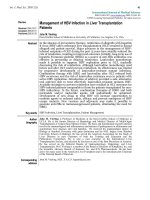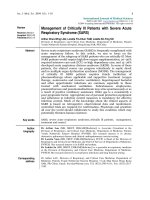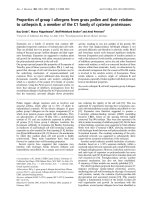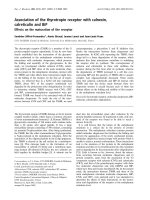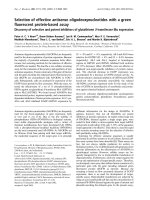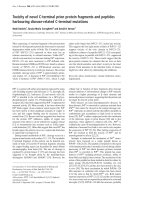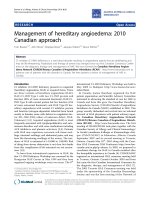Báo cáo y học: " Management of subtrochanteric femur fractures with internal fixation and recombinant human bone morphogenetic protein-7 in a patient with osteopetrosis: a case report" pot
Bạn đang xem bản rút gọn của tài liệu. Xem và tải ngay bản đầy đủ của tài liệu tại đây (523.53 KB, 5 trang )
JOURNAL OF MEDICAL
CASE REPORTS
Golden and Rodriguez Journal of Medical Case Reports 2010, 4:142
/>Open Access
CASE REPORT
© 2010 Golden and Rodriguez; licensee BioMed Central Ltd. This is an Open Access article distributed under the terms of the Creative
Commons Attribution License ( which permits unrestricted use, distribution, and repro-
duction in any medium, provided the original work is properly cited.
Case report
Management of subtrochanteric femur fractures
with internal fixation and recombinant human
bone morphogenetic protein-7 in a patient with
osteopetrosis: a case report
Robert D Golden and Edward K Rodriguez*
Abstract
Introduction: Osteopetrosis is a group of conditions characterized by defects in the osteoclastic function of the bone
resulting in defective bone resorption. Clinically, the condition is characterized by a dense, sclerotic, deformed bone
which, despite an increased density observable by radiography, often results in an increased propensity to fracture and
delayed union.
Case Presentation: We report the case of a 27-year-old Asian man presenting with bilateral subtrochanteric femur
fractures. He had a displaced right subtrochanteric femur fracture after a low-energy fall, which was treated surgically.
The second fracture that our patient endured was diagnosed as a stress fracture ten weeks later when he complained
of pain in the contralateral left thigh. By that time, the right-sided fracture exhibited no radiographic evidence of
healing, and when the left-sided stress fracture was being treated surgically, bone grafting with recombinant human
bone morphogenetic protein-7 was also performed on the right side.
Conclusion: While there are no data supporting the use of bone morphogenic proteins in the management of
delayed healing in patients with osteopetrosis, no other reliable osteoinductive grafting options are available to treat
this condition. Both fractures in our patient healed, but based on the serial radiographic assessment it is uncertain to
what degree the recombinant human bone morphogenetic protein-7 may have contributed to the successful
outcome. It may have also contributed to the formation of heterotopic bone around the fracture site. Further
investigation of the effectiveness and indications of bone morphogenic protein use for the management of delayed
fracture healing in patients with osteopetrosis is warranted.
Introduction
Osteopetrosis, originally described by Heinrich Albers-
Schönberg in 1904 [1], is now known to be a group of
conditions characterized by defects in osteoclastic func-
tion resulting in defective bone resorption [2]. Clinically,
the condition is characterized by dense, sclerotic,
deformed bones. Despite an increased density observable
by radiography, it often results in an increased propensity
for bones to fracture [3] and in problems with fracture
healing [4]. We report the case of a patient with a history
of osteopetrosis who first presented to our institution
with an acute traumatic right subtrochanteric femur frac-
ture and subsequently developed a stress fracture in a
similar location in the contralateral extremity. To the best
of our knowledge, this is the first reported case of the use
of bone morphogenetic proteins (BMPs) in the treatment
of a fracture in a patient with osteopetrosis.
Case Report
Our patient was a 27-year-old Asian man with a history
of osteopetrosis. He presented to the emergency depart-
ment after slipping on ice, and reported twisting his right
lower extremity before stabilizing himself with his left
leg. He denied falling or striking his leg against anything.
He complained of an immediate sharp pain in his right
* Correspondence:
1
Department of Orthopaedic Surgery, Beth Israel Deaconess Medical Center,
330 Brookline Avenue, Shapiro 2, Boston, MA, USA
Full list of author information is available at the end of the article
Golden and Rodriguez Journal of Medical Case Reports 2010, 4:142
/>Page 2 of 5
hip area, and was transported to the emergency depart-
ment via ambulance.
Our patient had a known history of osteopetrosis and
had previously suffered fractures in his left humerus, left
tibia and right femur. All previous injuries had been man-
aged non-operatively and healing had been prolonged.
Our patient was not taking any medication and was not
under continued management by any physician for his
osteopetrosis.
On examination, our patient was afebrile with stable
vital signs. His pelvis was stable and with no tenderness
on palpation. His left hip was non-tender throughout a
full range of motion. His right hip was tender to palpation
and to any passive motion. The right lower extremity was
neurologically intact to light touch sensation along all
distributions. Motor function was intact in all lower
extremity groups but our patient was unwilling to dem-
onstrate the full range of movements of his right hip
because of pain. All his extremities were well-perfused
with palpable distal pulses.
Radiographs revealed sclerotic bones consistent with
osteopetrosis. X-rays of our patient's pelvis, right hip,
right femur and chest were taken. There was a predomi-
nantly transverse fracture at the level of the lesser tro-
chanter with a mild degree of posterior displacement of
the distal fracture fragment (Figure 1). No left-sided sub-
trochanteric femur stress fracture was seen at this point.
Our patient was taken to the operating room the fol-
lowing morning for open reduction internal fixation with
a right angle dynamic compression screw (DCS) implant
(Synthes Inc, West Chester, PA, USA). The DCS implant
was chosen as it could be used to apply effective axial
compression along the transverse fracture and so to
achieve absolute stability. A blade plate would have been
an alternative implant but hammering the blade into
place would have risked fracture propagation. Due to the
extreme bone density of our patient and the lack of a fem-
oral canal, the use of an intramedullary device was dis-
counted. The procedure proved technically challenging
due to the density and brittle nature of his bone. The use
of numerous drill bits was required, with a prolonged
drilling time. Constant irrigation and pauses were needed
throughout the drilling process to prevent heat necrosis.
The drilling of the screw for the main lag screw of the
DCS system proved to be particularly difficult and time-
consuming. An eight-hole DCS plate with a 65 mm lag
screw was used and this was secured to the femur with
seven 4.5 mm cortical screws. The wound was closed
over a drain and our patient was taken to the recovery
room without incident. Intra-operatively, anatomic
reduction with good compression was achieved at the
fracture plane. Minimal dissection around the femur at
the fracture site was carried out to minimize soft tissue
stripping. The periosteum appeared to be normal in
appearance.
Our patient did well post-operatively and was dis-
charged to a rehabilitation facility on his third day after
surgery. He was initially allowed toe-touch weight bear-
ing only on his operative side. At follow-up four weeks
after his procedure, he was allowed to advance to 50%
partial weight bearing. At that time, he continued to com-
plain of some pain when walking, and discomfort while
internally and externally rotating his hip. Radiographs
demonstrated the hardware to be intact with satisfactory
alignment of the fracture fragments but with no evidence
of callus formation or other signs of progressive healing.
Our patient returned for follow-up 10 weeks after his sur-
gery and radiographs still failed to demonstrate any evi-
dence whatsoever of a healing progression (Figure 2a). In
addition, our patient reported contralateral upper thigh
pain. A stress fracture on his contralateral femur was
noted at the same level as the fracture managed opera-
tively on the right side 10 weeks earlier (Figure 2b).
After discussion with our patient, it was recommended
that he should return to the operating room to undergo
internal fixation of the stress fracture in his left femur
Figure 1 Anteroposterior and lateral radiographs of our patient's
right hip at the time of initial presentation to the emergency de-
partment.
Figure 2 (a) Anteroposterior radiograph of the pelvis obtained 10
weeks after initial fixation. Note the lack of healing progression of
the right femoral fracture and the stress fracture now visible in the left
femur and better demonstrated in (b).
Golden and Rodriguez Journal of Medical Case Reports 2010, 4:142
/>Page 3 of 5
before it became a complete fracture like the one on the
right side. In retrospect, there is radiographic evidence
that the right-sided fracture was a stress fracture which
had progressed to a displaced fracture after a relatively
minor fall. Because our patient was going to have his left
side fixed, and because of the poor progression of healing
at this point, we also recommended that he underwent
prophylactic bone grafting of the right side at the same
time. We recommended the use of recombinant human
bone morphogenetic protein-7 (rhBMP-7) to his right-
sided fracture, citing his history of delayed healing of
fractures, as evidenced by the slow healing from radio-
graphs on his right side 10 weeks after the operation, as
well as out of concern for early hardware failure in a rela-
tively young and active patient.
The use of BMP graft was recommended in lieu of an
iliac crest graft, given the expected difficulty of harvest-
ing osteopetrotic crest as well as the questionable use of
osteopetrotic bone as a useful grafting material. No data
are available on the osteoinductive and osteoconductive
properties of osteopetrotic bone. Furthermore, we feared
that the process of harvesting iliac crest bone for grafting
could put our patient at risk of a pelvic or acetabular frac-
ture progression, given the brittle nature of his bone. He
was informed that while rhBMP-7 has been approved for
the treatment of nonunions in long bones, there were no
data supporting its effectiveness in treating delayed long
bone healing in patients with osteopetrosis. He agreed to
the use of rhBMP-7 and informed consent was obtained.
No plans were made to graft the left side, given that it was
a newly diagnosed fracture. We did not seek approval
from our Institutional Review Committee for the use of
rhBMP-7 in a primary fracture which is currently not a
Food and Drug Administration (FDA) approved proce-
dure.
Our patient was brought to the operating room and
underwent internal fixation of his stress fracture with a
six-hole DCS construct utilizing a 60 mm lag screw. Once
again, due to the extreme bone density of our patient, a
prolonged drilling time with multiple drill bits was
required. The right fracture site was grafted with a single
dose of rhBMP-7 (OP-1
®
, Stryker Biotech, Hopkinton,
MA, USA) through a smaller exposure along the original
incision.
The post-operative course of our patient was unre-
markable and he was discharged to a rehabilitation facil-
ity on post-operative day three. Follow-up radiographs
obtained approximately six weeks after his second sur-
gery demonstrated the hardware to be intact, but still no
further healing of the initial fracture site on the right side
was evident. Some early heterotopic bone formation was
noted at the grafting site on the right side. At this point,
our patient had weaned off of his postoperative pain con-
trol regimen consisting of 10 mg oxycodone/acetamino-
phen every four hours as need and was able to walk
without a walker but felt safer with the support of a cane
or a single crutch. He did, however, continue to complain
of pain in his right hip during ambulation. Five and a half
months after the operation, our patient continued to
ambulate with a mildly antalgic gait. A computed tomog-
raphy (CT) scan was carried out which showed some evi-
dence of fracture healing, but the fracture lines were still
visible at that time.
Expectant management of our patient continued, and
two years after his operations, radiographs continued to
show visible, but less sharply defined fracture lines of his
right hip (Figure 3). There was also evidence of mature
heterotopic bone formation. There were no fracture lines
visible on the left-sided stress fracture and there was no
evidence of any loosening or hardware failure at either
fracture site. Our patient walked with a non-antalgic gait
and did not require any assistive devices. He had begun
work as a dentist and stated that he could work all day on
his feet without difficulty, but admitted to some fatigue
with mild bilateral discomfort at the end of long days. His
symptoms, however, were primarily focused at both
groins and were more consistent with osteoarthritic pain.
He neither ran nor participated in other athletic activi-
ties. He had 5/5 motor strength in all lower extremity
muscle groups. He had not had any other orthopedic
injuries since the time of his femur fractures.
Our patient moved out of our geographical area but
kept in contact. About three years after his procedures,
he contacted our office to request a referral to an ortho-
paedic surgeon closer to his new area of residence with
experience of treating osteopetrosis. He was developing
further osteoarthritic hip changes and needed advice
Figure 3 Anteroposterior radiograph of the pelvis at the two-
year follow-up appointment demonstrating attenuated but still
visible fracture lines on the right side.
Golden and Rodriguez Journal of Medical Case Reports 2010, 4:142
/>Page 4 of 5
regarding his options for arthroplasty versus resurfacing.
Three years after his fractures, he had had no failure of
fixation or other complications. He eventually underwent
a total right hip arthroplasty at about 4 years from his ini-
tial fracture. We received a report that an initially
planned resurfacing procedure was aborted due to the
presence of femoral neck stress fractures. However, the
subtrochanteric fracture was well healed. The left-sided
fracture had no issues four years after its surgical man-
agement.
Discussion
Osteopetrosis represents a group of conditions with
defects in osteoclastic function resulting in defective
bone resorption [2]. Armstrong, et al. conducted a survey
using the members of the Pediatric Orthopedic Society of
North America in an attempt to elucidate the optimal
methods of treatment for fractures occurring in patients
with osteopetrosis. Respondants cited various options for
treatment but a consistent response from the participants
regarded the difficulty in placing an internal fixation
device secondary to the increased bone density.
Treatment without surgery was often reported to pro-
duce satisfactory results, although the rate of healing was
frequently noted to be prolonged. Similar problems were
seen with internal fixation, with case reports of delayed
union of up to two years [4]. This is possibly due to the
fact that the fracture callus in patients with osteopetrosis
has been shown to be abnormal, with a continuation of
unorganized woven bone and a lack of lamellar organiza-
tion after one year, even in healed fractures [5]. A review
of the osteopetrotic case reports by Birmingham and
McHale [6] revealed a large variability in the healing rates
of operatively-treated fractures, ranging from two
months to two years, and with a few cases of nonunion.
Actual case reports of nonunion in patients with osteo-
petrosis are rare in the literature [7,8].
Urist first described osteoinduction, later ascribed to
BMPs, in 1965 [9]. There are now at least 18 different
BMP molecules described, of which eight have been
shown to have osteoinductive properties [10]. BMPs act
on mesenchymal cells by inducing the recruitment of
mesenchymal precursors from muscle and surrounding
tissues into the fracture site, inducing osteoblast and
chondrocyte differentiation, and inducing angiogenesis
and eventual bone formation [11]. Currently, only two
BMPs produced using recombinant gene technology have
been commercialized: BMP-2 (Infuse
®
, Medtronic Sofa-
mor, Minneapolis, MN, USA) and BMP-7 (OP-1
®
, Stryker
Biotech, West Chester, PA, USA); and these are limited to
approved applications in trauma and spinal fusion [12]. In
particular, rhBMP-7 is approved for use in recalcitrant
nonunions of long bones. Some studies have demon-
strated that the use of BMPs is comparable with
autografting in the treatment of nonunions without the
morbidity associated with autograft harvesting and with a
lower risk of infection than in those patients treated with
autograft [10,12].
The osteoinductivity of BMPs also follows a dose-
response ratio in which the local concentration of a BMP
determines the clinical response. If the concentration is
too low, inadequate bone formation will occur; if the dose
is too high, heterotopic ossification might be expected,
although this has not been shown to occur under physio-
logical conditions, but it possibly does in osteopetrosis
[13]. BMPs have also been shown to not only affect osteo-
blast activity, but also to stimulate osteoclast activity and
osteoclastogenesis [14]. In fact, higher doses appear to
often result in initial localized bone resoprtion [10]. How-
ever, it is unclear whether this effect will be seen in osteo-
petrotic bone with its underlying osteoclastic deficiency.
To the best of our knowledge, this is the first report of
the use of BMP in the management of a femur fracture in
a patient with osteopetrosis. Rafiq et al. reported the first
case of the use of BMPs in osteopetrosis, referring to a
humerus shaft fracture nonunion [8]. We report the
results of a patient with bilateral femur fractures and
osteopetrosis who was treated with internal fixation and
rhBMP-7 grafting after his first fracture failed to show
any signs of healing 10 weeks after an initial repair. Dur-
ing follow-up, our patient had some minor heterotopic
bone formation on his right side and persistent radio-
graphically apparent fracture lines suggesting some
degree of incomplete healing at that site. However, there
was no evidence of hardware failure suggesting a non-
union, and little discomfort and antalgia. Our patient also
returned to full activity and remained complication-free
on both sides for four years when a right hemiarthro-
plasty was performed for progressive hip osteoarthritis,
at which time the hardware was removed and the frac-
tures were confirmed to be healed. While we have no
means of assessing to what extent the use of rhBMP-7
contributed to the healing process, and thus no firm evi-
dence that it contributed at all, its use as an alternative to
autologous bone graft in patients with osteopetrosis is an
option for consideration. Further research to establish
effectiveness and indications is warranted.
Consent
Written informed consent was obtained from the patient
for publication of this case report and any accompanying
images. A copy of the written consent is available for
review by the Editor-in-Chief of this journal.
Competing interests
The authors declare that they have no competing interests.
Golden and Rodriguez Journal of Medical Case Reports 2010, 4:142
/>Page 5 of 5
Authors' contributions
RDG examined the data, did the analysis and prepared the manuscript. EKR did
the surgical intervention, conducted the post-operation follow-up, examined
the data, did the analysis and prepared the manuscript. All authors read and
approved the final manuscript.
Author Details
Department of Orthopaedic Surgery, Beth Israel Deaconess Medical Center,
330 Brookline Avenue, Shapiro 2, Boston, MA, USA
References
1. Albers-Schönberg HE: Röntgenbilder einer seltenen
Knocknerkrankung. Munch Med Wochenschr 1904, 51:365-368.
2. Tolar J, Teitelbaum SL, Orchard PJ: Osteopetrosis. N Engl J Med 2004,
351(27):2839-2849.
3. Greenfield JR, Center JR, Freund J, Eisman JA: Treatment of an atraumatic
fracture: the importance of establishing a definitive diagnosis. J Bone
Miner Res 2001, 16(12):2362-2364.
4. Armstrong DG, Newfield JT, Gillespie R: Orthopedic management of
osteopetrosis: results of a survey and review of the literature. J Pediatr
Orthop 1999, 19:122-132.
5. De Palma L, Tulli A, Maccauro G, Sabetta SP, del Torto M: Fracture callus in
osteopetrosis. Clin Orthop Relat Res 1994, 308:85-89.
6. Birmingham P, McHale KA: Case reports: treatment of subtrochanteric
and ipsilateral femoral neck fractures in an adult with osteopetrosis.
Clin Orthop Relat Res 2008, 466:2002-2008.
7. Steinwater G, Hosny GA, Hoch S, Grill F: Bilateral nonunited femoral neck
fracture in a child with osteoprosis. J Pediatr Orthop B 1995,
4(2):213-215.
8. Rafiq I, Kapoor A, Burton DJC, Haines JF: A new modality of treatment for
non-united fracture of humerus in a patient with osteopetrosis: a case
report. J Med Case Reports 2009, 3:15-18.
9. Urist MR: Bone: formation by autoinduction. Science 1965, 150:893-899.
10. Termaat MF, Den Boer FC, Bakker FC, Patka P, Haarman HJ: Bone
morphogenetic proteins. Development and clinical efficacy in the
treatment of fractures and bone defects. J Bone Joint Surg Am 2005,
87(6):1367-1378.
11. Kwong FNK, Harris MB: Recent developments in the biology of fracture
repair. J Am Acad Orthop Surg 2008, 16:619-625.
12. Mont MA, Ragland PS, Biggins B, Friedlander G, Patel T, Cook S, Etienne G,
Shimmin A, Kildey R, Rueger DC, Einhorn TA: Use of bone morphogenetic
proteins for musculoskeletal applications. An overview. J Bone Joint
Surg Am 2004, 86-A(Suppl 2):41-55.
13. Miyazawa K, Kawai T, Urist MR: Bone morphogenetic protein-induced
heterotopic bone in osteopetrosis. Clin Orthop Relat Res 1996,
324:259-268.
14. Itoh K, Udagawa N, Katagiri T, Iemura S, Ueno N, Yasuda H, Higashio K,
Quinn JM, Gillespie MT, Martin TJ, Suda T, Takahashi N: Bone
morphogenetic protein 2 stimulates osteoclast differentiation and
survival supported by receptor activator of nuclear factor-κB ligand.
Endocrinology 2001, 142(8):3656-3662.
doi: 10.1186/1752-1947-4-142
Cite this article as: Golden and Rodriguez, Management of subtrochanteric
femur fractures with internal fixation and recombinant human bone mor-
phogenetic protein-7 in a patient with osteopetrosis: a case report Journal of
Medical Case Reports 2010, 4:142
Received: 21 October 2009 Accepted: 19 May 2010
Published: 19 May 2010
This article is available from: 2010 Golden and Rodriguez; licensee BioMed Central Ltd. This is an Open Access article distributed under the terms of the Creative Commons Attribution License ( ), which permits unrestricted use, distribution, and reproduction in any medium, provided the original work is properly cited.Journal of Medical Case Reports 2010, 4:142

